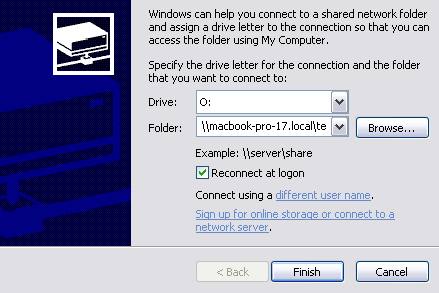Parallels For Mac Map Network Drive
In the Preferences for Parallels you can specify whether you want USB devices to be auto-connected upon detection or not. Sounds like you have this option turned off. To change it, you need to shut down your virtual machine, if it’s running, and then choose Edit –> Virtual Machine, within which you’ll find one of the options is: On mine you can see that I have my Connection Options set to “Connect to Guest OS”: yours is set to “Connect to Mac OS” instead.
Lightning Fast Graphic and resource-hungry Windows applications run effortlessly without slowing down your Mac. Run the most demanding applications such as Adobe ® Photoshop ®, Visual Studio ®, or SketchUp ®.
Rich media player for mac. Automatically Connect to a Network Drive on Mac OS X Start Up & Login. May 4, 2012 - 23 Comments. If you’re already familiar with mapping a network drive in Mac OS X you can skip the first part of this and go straight to System Preferences in the second section. Parallels ® Network Sharing Guest to Host and Host to Guest. A Windows XP (or 2000) guest OS must be able to map to a fixed drive letter in the host. The guest should be able to access the local network resources and the internet. Parallels 2.1 GA release Windows XP SP2+ Mac OS X 10.4.7. First, obtain all of the above software, perform. Skype for business chat group.
Parallels For Mac Reviews
Before, I couldn’t get Parallels to notice the external HD when I connected it. By finding this site, I found out I needed to go into this configuration editor and select “Connect USB Devices automatically.” However, the problem’s still not solved. When I connect an external USB, it says that someone else is trying to access it (I assume the Mac).

Someone here was comparing the Parallel Desktops to VMWare, which i know for sure is much slower (the virtualization overhead is definitely visible). Is it just you being enthusiastic (which i would definitely understand:) or is it really comparable to a non-virtualized pc installation? Dave - • Why would we make it up?
Important: If you don't see Check for Updates on the Help menu, download the latest version of the Microsoft AutoUpdate tool. Run the tool and then start over at step 1. The Check for Updates option now appears on the Help menu. Microsoft PowerPoint 10.1.9 - For Microsoft Office v.X (not 2004 or 2008). Download the latest versions of the best Mac apps at safe and trusted MacUpdate Download, install, or update Microsoft PowerPoint for Mac from MacUpdate. Microsoft powerpoint updates for mac.
How might I do this with a Mac? It connects immediately because it's Windows connecting to Windows. Microsoft doesn't work with other platforms to make it easy to connect to protect their product. All other platforms (Mac, Linux, Unix, etc) have to use SAMBA to connect to Windows shares. The quickest way for a Mac user to connect is to switch to the Finder then hit COMMAND+k and then type as HWeyer mentioned smb://SERVERNAME. You can always type the complete share path if you know it to.
So now I have two distinct Windows installs -- one Parallels and one BootCamp. It's probably for the best, anyway, since they're for different uses. I found my solution shortly after I posted (which seems to happen to me frequently in the GB). If you go to Virtual Machine -> Edit (when the VM isn't running), you can specify which folders Parallels should map. When I specifically map those drives as shared folders, it runs pretty well. (Previously, I had the whole system mapped, and browsing to my network drives was painfully slow.) It works beautifully now, and my new MBP is finally fully set up for work. It took me a few days, but I have a great setup now thanks to Parallels and Virtue Desktops.
This may be inconvenient because it splits your limited storage into yet another partition, but it’s an option. Use External Drives or Cloud Storage If this is all too annoying, you may want to forget about your Mac’s internal drive.
So you need to manually install and set them up, afterwards you will need to map a network drive on your Mac. Mapping a network is a process, where you reveal the path to a storage device attached to a network. There are two methods how to map your network drive on Mac. First would be for temporary use, where you loose your path to network drive after restart. The second would be a permanent one, where your Mac will detect and mount the network drive every time it connect to the same network with attached storage. Speaking about business, network storage usually comes in the form of server storage, SANs (storage area network), NAS (network attached storage) and cloud services.
Sharing Windows to Mac Host in Parallels Parallels ® Network Sharing Guest to Host and Host to Guest Using Bridged Connections The problem: Parallels is great but it lacks a good guest to host and vice versa file sharing mechanism. Furthermore, there are a number of issues getting the guest to see the host and the rest of the world at the same time when your computer is mobile like a traveling consultant's laptop might be. Try as we might, we found that none of the myriad of solutions worked for us and solved these fundamental requirements: • A Windows XP (or 2000) guest OS must be able to map to a fixed drive letter in the host. • The guest should be able to access the local network resources and the internet.
Comments are closed.